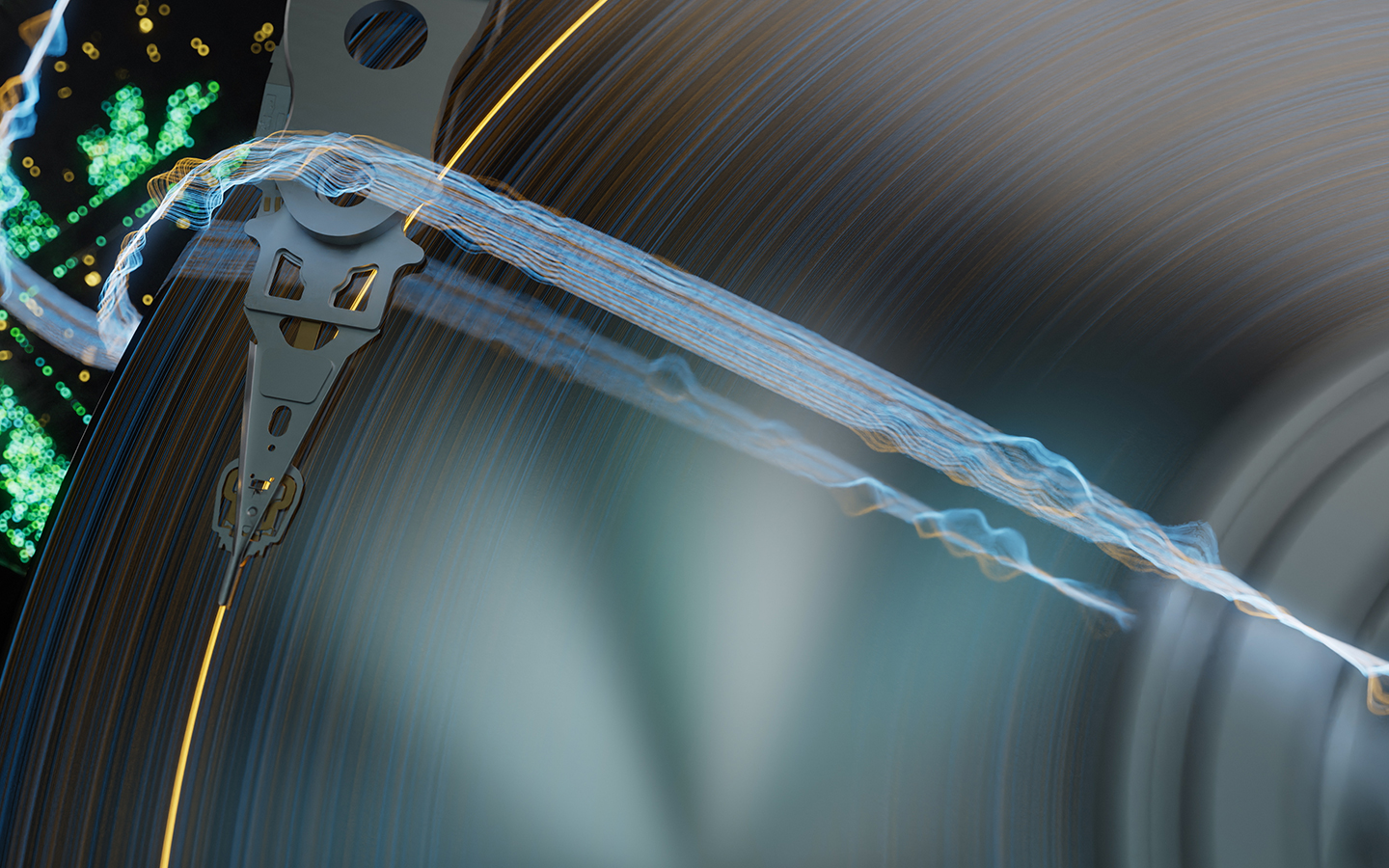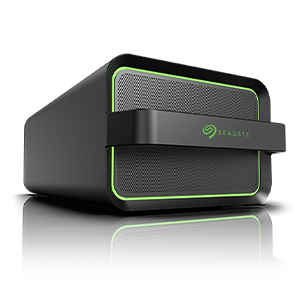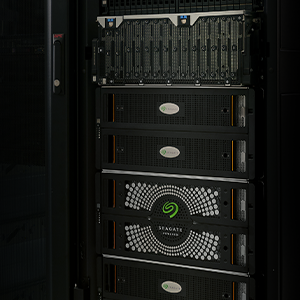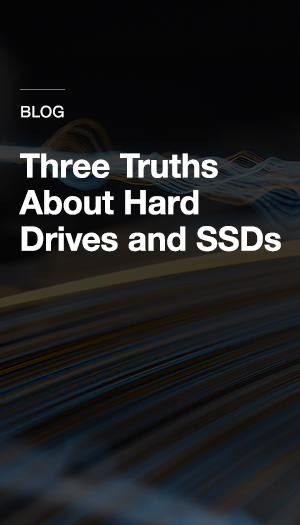
In modern data centers, where racks of hard drives churn relentlessly to meet growing data demands, maintaining storage reliability is as vital as expanding capacity. Yet, the pursuit of higher areal density—the most efficient and cost-effective way of increasing hard drive capacity—inevitably introduces new challenges. Among the most pressing is the issue of track squeeze, a phenomenon that grows more problematic in the high-vibration environments typical of densely packed data centers. Addressing this challenge is critical not only to protect data integrity but also to support the broader systems and applications that depend on reliable storage.
The nature of track squeeze in hard drives.
Track squeeze occurs when the concentric rings of data written on a hard drive platter, known as data tracks or cylinders, are pushed out of their intended alignment. This can happen due to environmental factors like vibration from server fans, cooling systems, or densely packed racks. As Seagate principal engineer Josiah Wernow explains, this disturbance can distort the track path, creating an effect similar to “a distracted driver on the freeway.”
Such misalignments pose a severe risk to data integrity. If tracks drift into adjacent ones, the read/write heads may struggle to locate or recover data, potentially leading to what’s known as sector failure. In some cases, the data in affected areas may become permanently unrecoverable. The ramifications are clear: for cloud providers and enterprises, even minor disruptions in storage reliability can cascade into larger operational challenges, including downtime, data loss, and customer dissatisfaction.
Implications of track squeeze for cloud data centers and beyond.
For organizations operating in cloud or enterprise environments, the stakes are high. Data centers house critical information supporting global finance, healthcare systems, AI workloads, and countless other sectors. When track squeeze occurs, its effects ripple outward, jeopardizing entire workflows.
The broader implications extend to the IT infrastructure ecosystem. If data reliability falters due to track squeeze, organizations are forced to invest more in redundancy, backups, and error-correction measures, driving up costs and slowing innovation. For end users, this could mean interruptions in streaming services, delays in AI-driven insights, or errors in mission-critical operations such as supply chain management or patient care.
Engineering solutions to address track squeeze.
Overcoming track squeeze requires addressing its root causes and its technological consequences. Seagate developed a range of innovations to ensure that higher density does not come at the expense of reliability.
Dual-stage actuation is one such solution. By adding a secondary actuator to refine the positioning of the read/write heads, dual-stage systems improve precision even in environments where vibration is a factor. This level of control ensures that the heads remain aligned with the target tracks.
Further advancements include helium-sealed drives, which replace the air inside a hard drive with helium. Helium, being lighter and less dense than air, creates less internal turbulence and vibration. This improves the drive’s ability to maintain track alignment, even under demanding conditions.
Seagate’s innovations extend to tri-stage actuation, an evolution of dual-stage systems. By introducing a third level of control, tri-stage actuation provides an additional layer of precision to counteract the effects of severe vibration. As Wernow describes, this system is akin to adding a dock worker with extended arms to guide cargo into place more accurately during turbulent conditions.
OC Lim keeps heads on track.
Another critical measure is the enforcement of On-Cylinder Limit (OC Lim) technology. Acting as a guardrail, OC Lim prevents the read/write head from drifting off track, where it could corrupt adjacent data. OC Lim functions as a dynamic safeguard embedded in the hard drive’s firmware. It continuously monitors the position of the read/write head as it operates across the narrow tracks of a high-density hard drive. This system works by establishing predefined positional limits—essentially a boundary or "guardrail"—that the head cannot exceed while writing data.
When a write operation is initiated, OC Lim tracks the head's alignment using real-time positional feedback from the drive's sensors. If the head begins to drift beyond these set limits, OC Lim intervenes by halting the write operation. This prevents the head from inadvertently overwriting or corrupting data on adjacent tracks.
This system can be adaptive; its boundaries are not static. In dynamic OC Lim implementations, these positional limits can adjust based on the drive’s operating conditions, such as temperature fluctuations or environmental vibration levels. By adapting in real-time, OC Lim ensures that the head operates within safe margins, even as conditions vary.
Overall, OC Lim works by creating a buffer zone around each track, effectively enforcing precision during write operations. Its role is especially critical as track widths shrink to accommodate higher capacities, making even minor deviations potentially catastrophic. Through this mechanism, OC Lim protects the integrity of stored data while maintaining operational efficiency.
Collaboration with customers for tailored solutions.
Seagate’s innovations are not developed in isolation; they are shaped by close collaboration with data center operators who face unique challenges in their environments. For instance, some facilities operate in extreme temperature or vibration conditions, requiring drives to be finely tuned for specific workloads. By integrating features like dynamic OC Lim, Seagate ensures that its solutions are not only effective but also versatile enough to meet diverse customer needs.
This collaborative approach extends beyond hardware. Seagate works with customers to simulate high-vibration environments and optimize placement within racks. These efforts, combined with firmware advancements that detect and correct vibrations, ensure that drives are equipped to handle real-world challenges.
A foundation for the broader technology landscape.
The impact of these innovations goes far beyond preventing track squeeze. By ensuring data reliability in high-vibration environments, Seagate enables the continued scalability of data centers, which in turn supports critical industries and emerging technologies. AI workloads, for example, rely on uninterrupted access to vast datasets to function effectively. Storage reliability ensures that such workloads can operate without disruption, advancing fields like autonomous systems, medical diagnostics, and natural language processing.
The ripple effects of Seagate’s efforts can also be seen in the cost-efficiency of IT systems. By mitigating track squeeze in enterprise drives and reducing the need for expensive cooling or redundancy measures, Seagate helps data centers achieve higher capacities at lower total costs of ownership (TCO). This contributes to a more sustainable storage ecosystem, benefiting organizations and end users alike.
Continuous innovation is required.
The challenges of track squeeze and high-vibration environments will continue to evolve as data center demands grow. Seagate’s commitment to innovation ensures that its storage solutions remain at the forefront of these challenges. From tri-stage actuation to helium drives and beyond, Seagate is solving today’s problems but also laying the groundwork for future advancements in data storage technology.
As Wernow notes, “The precision we need to achieve is incredible. But that’s what makes the work worth doing.” Through its engineers’ efforts, Seagate is safeguarding the integrity of data storage, supporting the growth of data, and ensuring the seamless access to the critical information that powers industries, connects communities, and drives innovation worldwide.






